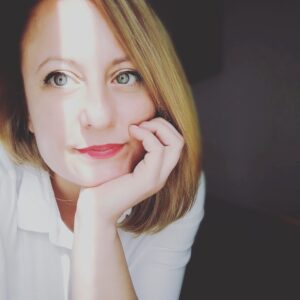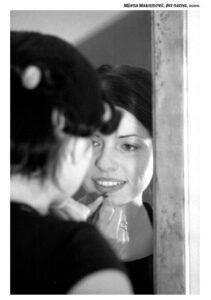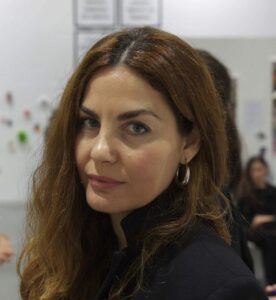Lenka Klodová

– born in 1969 in Opava, Czechoslovakia. She is a visual artist and her performances and conceptual projects are based on her artistic research in which she deals with nudity, sexuality, motherhood and the position of women in society. Since 1998 she has run the company Strašné dítě [A Terrible Child] together with Helena Poláková and Lucie Nepasická, in which they design playgrounds for children. In 2001, she founded the art collective with her friends called Mothers and Fathers, which has been drawing inspiration from their parenting experiences. Since 2015 she has been organizing the Festival of Naked Forms and she is currently running the Body Design Studio at the Faculty of Fine Arts and the Brno University of Technology.
My path to politics leads through personal experience
Artistic research is a category whose significance is constantly shifting and evolving. I have been leading the Body Design Studio at the Faculty of Fine Arts at the Brno University of Technology for over ten years, and artistic research is something that is constantly being discussed with the students. One of its meanings may lie in its supporting role for artistic practices as related to certain expertise. For example, together with the non-profit organisation Nesehnutí, the students and I have recently proposed alternative didactic-artistic ways of teaching sex education in high schools. In my own artistic practice, for myself, I define artistic research in the simplest form, namely as a certain exploration of the field of interest, which becomes visible subsequently in retrospect, when individual and gradually emerging projects appear at a certain point in time as different ways and approaches to one singular topic.
I succeeded in such a series around the year 2000 when I started dealing with the representation of sexuality. First I began deconstructing erotic magazines for men, which were being sold at the time, through my own interventions in their visual material, to then attempt to create erotic magazines for women1234. My interest in the representations of the naked body in the public space gradually grew into my own performances, in which I also work with nudity. At the same time, I have been organising and curating the Festival of Naked Forms for several years now, within which I try to look at this topic from various authorial perspectives that include different gender, age and generational positions, all with the help of invited international artists56.
In the mid-1990s, when I was studying at the Academy of Arts, Architecture, and Design in Prague, the word identity was not used within the art scene. Although there was a tradition of artists who based their work on their lived experience as women, their art was being discussed mainly in terms of visuality and technical execution. For me, it was therefore an immense discovery that the subject of art can be something entirely private or that the content of the work can dominate over its form. It was personally interesting to observe how these notions gradually became a part of the current vocabulary.
In my opinion, there are two approaches to the positioning of politics in art. The first one is based on one’s own experience, which the author transforms into their artistic statement. The topics of sexuality and motherhood that I have worked with have also always been rooted in my personal life7891011121314. And the second position is that of making a kind of a manifestation to help with a specific political and social situation. This is, in a positive sense, the service function of art. For example, Tamara Moyzes has recently asked me and a few other artists if we wanted to create a work in support of the Russian artist Julia Cvetkova, regarding a specific case concerning freedom of expression.
Currently, I am in the phase of life when children are growing up and they are moving out. Partially, this has dried up one of my natural sources of inspiration. I am waiting for the next phase of my life to become articulated in a more significant manner. One of the things that I could be processing right now is some of my physical changes that are occurring, the beginning of the process of ageing. It is interesting for me to watch how my changing body shifts the content of my performances for example. I wonder how ageing will affect the humour and exaggeration that are present in them. That is the main path towards personal politics for me now. One has the evidence they can testify about.
I perceive my practice of creating original children’s playgrounds in a sense as more political than my own artistic work. For the creation of the playgrounds, I collaborate with Helena Poláková and Lucie Nepasická, but I also do not perceive this as purely artistic. As three women we are constantly dealing with much prejudice on the part of construction companies, sometimes even contracting authorities. At the same time, this project is about working with the landscape and care of local and community dimensions15.
Ten years ago, when I first joined the Faculty of Fine Arts as a teacher, I had no idea how big of a question gender would be when it comes to the functioning of this institution. The longer I work here the more I see how important this issue is and how slowly it is being addressed at the institutional level, even though we now have a dean who is as open as possible. But no one wants to introduce any quotas. However, neither will it fix itself through a natural course (currently, the ratio in the leadership of the studios is 4:12 to the detriment of women). It’s the same as planting flowers — first, they have to be fertilised so they could continue growing themselves.
At the same time, I myself am aware of how difficult it is to change structural problems. At the end of the 1990s, I collaborated on joint projects with Petra Sovová and other activists from the Movement for Active Motherhood. At the time, we thought we were facing a resolution regarding the possibility of births at home. However, the situation turned in the opposite direction and maternity homes began to close. Now when I am looking at the work of my doctoral student Kateřina Olivová, it fills me with sadness that the current generation is solving similar issues that were also on our agenda twenty years ago1617181920.
As for my teaching position, I am constantly doubting my pedagogical approaches, which should probably be a part of it. From my point of view, the role of a teacher at the secondary and primary schools should be didactic and psychological, while at the university it is primarily about expertise, and the pedagogue should embody a personal example. I try to be such a node, offering my experience and contacts to individually provide each student with the best possible conditions and opportunities for their own direction21.
The text was created in collaboration with Marianna Placáková (2021).
1Image: Lenka Klodová, In hands, 2001. Courtesy of the artist.2Image: Lenka Klodová, Ženín. Magazine for Woman and Excitement, 2005. Courtesy of the artist.
3Lenka Klodová. Moje ženy[My women], Prostějov: Galerie Pokorný 2001.
4Lenka Klodová. Ženin 1/05, Praha: VŠUP 2005.
5See: http://www.fnaf.fun/.
6Lenka Klodová, Nudity as a normal state: neither beautiful, nor ugly, nor eroticism, nor sensation, see: https://artalk.cz/2018/03/13/nahota-jako-normalni-stav-ani-krasna-ani-oskliva-ani-erotika-ani-senzace/.
7Mothers and fathers, Family Art Crimes, 2006, see: http://archiv.artwall.cz/index.php?option=com_rsgallery2&Itemid=104&catid=1&lang=cz.
8Charlotta Kotík, Post-Totalirian Art: Eastern and Central Europe, [in:] Maura Reilly, Linda Nochlin (eds.), "Global Feminisms. New Directions in Contemporary Art", New York, Brooklyn Museum 2007, s. 157-159.
9Image: Lenka Klodová, My Stockings, 2003. Courtesy of the artist.
10Barbara Curtis, Artist-Parents in Contemporary Art. Gender, Identity, and Domesticity, New York, Routledge 2020.
11Lenka Klodová, Lenka Klodová. Libát, 2006, Gallery DO/OKA, Prague.
12Jiří Surůvka, Story of women Klodové!, Ateliér, 2011, roč. 24, č. 7, s. 4.
13Image: Lenka Klodová, Demonstration, 2005, exhibition Men Menstruating This Month, Brno: U dobrého pastýře Gallery, 2005. Courtesy of the artist.
14Image: Lenka Klodová, Are You Afraid of Motherhood?, performance, 2003 Courtesy of the artist.
15See: http://www.strasnedite.cz/
16Lenka Kukurova, Lenka Klodova. ‘Gender, Nudity and the Shifting of Social Norms’, Flash Art Czech & Slovak Edition, vol. 14, No. 50, 2019, pp. 24-39, see: https://flashart.cz/2019/12/09/lenka-klodova-rod-nahota-a-posuvanie-spolocenskych-noriem/.
17Kateřina Černá, ‘Woman Doesn't Need a Head’, Art & Antiques, October 2008, see: https://www.artantiques.cz/zena-hlavu-nepotrebuje.
18Lenka Klodová, I Was Terribly Embarrassed, But Only That First Time, [in:] Zuzana Štefková (ed.), "Testimonies. In a Female Voice", 2012, see: http://testimonies.umprum.cz/en/lenka-klodova.html.
19 Martina Pachmanová, Everyday life for artistic metaphysics, interview with Lenka Klodová, [in:] Pavlína Morganová (ed.), "Sometimes in a Skirt. Art of the 1990s", Moravian Gallery, Brno, pp. 99–105.
20Lenka Vítková, Lenka Klodová. Profil, [in:] Umělec, 2007, č. 10, s. 16-21.
21See: https://wave.rozhlas.cz/lenka-klodova-o-androgynekologii-5269872.
– narozena 1969 v Opavě v Československu – vizuální umělkyně, ve svých performancích a konceptuálních projektech založených na uměleckém výzkumu se zabývá nahotou, sexualitou, mateřstvím, pozicí ženy ve společnosti, od roku 1998 vede společně s Helenou Polákovou a Lucií Nepasickou firmu Strašné dítě, v níž projektují dětská hřiště, v roce 2001 založila s přáteli uměleckou skupinu Matky a Otcové, která čerpá inspiraci z rodičovské zkušenosti, od roku 2015 pořádá Festival nahých forem, v současnosti vede Ateliér tělového designu na Fakultě výtvarného umění VUT v Brně.
Moje cesta k političnosti vede skrze osobní zkušenost
Umělecký výzkum je kategorie, jejíž význam se neustále vyvíjí a posouvá. Sama vedu již přes deset let Ateliér tělového designu na Fakultě výtvarného umění VUT v Brně a umělecký výzkum je něco, o čem se se studenty neustále bavíme. Jeden jeho význam může spočívat v jeho podpůrné roli pro uměleckou praxi, související s určitou expertizou. Se studenty jsme nyní například společně s neziskovou organizací Nesehnutí navrhovali alternativní didakticko-umělecké způsoby, jak učit sexuální výchovu na středních školách. V autorské tvorbě sama pro sebe definuji umělecký výzkum v nejjednodušší formě a to sice jako určité probádávání pole zájmu, které je pak až zpětně viditelné, když se jednotlivé a postupně vzniklé projekty ukážou v jeden čas jako různé způsoby a přístupy k jednomu tématu.
Mně se taková série povedla kolem roku 2000, kdy jsem se začala zabývat prezentací sexuality. Nejdříve jsem začala dekonstruovat erotické časopisy pro muže, které se v té době prodávaly, vlastními intervencemi do jejich obrazového materiálu, potom jsem se pokoušela vytvářet erotické časopisy pro ženy1234. Můj zájem o reprezentaci nahého těla ve veřejném prostoru postupně přerostl až do vlastních performancí, v nichž pracuji s nahotou. Zároveň už několik let organizuji a kurátoruji Festival nahých forem, v rámci kterého se toto téma za pomocí pozvaných mezinárodních umělců snažím ohledávat z různých autorských genderových, věkových i generačních pozic56.
V polovině devadesátých let, když jsem studovala na Vysoké škole uměleckoprůmyslové v Praze, se slovo identita na umělecké scéně nepoužívalo. Přestože zde existovala tradice umělkyň, které ve své tvorbě ze své zkušenosti žen vycházely, o jejich umění se mluvilo hlavně z hlediska vizuality a technického provedení. Pro mě to byl proto obrovský objev, že tématem umění může být něco zcela soukromého a také to, že může dominovat obsah díla nad jeho formou. Bylo pro mě zajímavé sledovat, jak se tyto skutečnosti postupně stávají součástí současného slovníku.
Podle mne existují dvě polohy političnosti v umění. Ta první je založena na vlastní zkušenosti, kterou autor transformuje do umělecké výpovědi. Témata sexuality a mateřství, které jsem zpracovávala, měla také vždy kořeny v mém osobním životě7891011121314. A druhá pozice je ta, že člověk udělá nějakou věc jako manifestaci, aby pomohl konkrétní politicko-společenské situaci. To je v pozitivním smyslu služebná funkce umění. Například před nedávnem mne společně ještě s ostatními umělci vyzvala Tamara Moyzes, jestli nechceme vytvořit dílo na podporu ruské umělkyně Julie Cvetkové – jde o konkrétní kauzu, týkající se svobody projevu.
Dnes jsem v životní fázi, kdy odrostou děti, odstěhují se. Částečně tím vyschnul jeden z mých přirozených zdrojů inspirace. Čekám, až se výrazněji artikuluje další životní fáze. Co teď můžu zpracovávat, jsou nějaké mé fyzické změny, začínající proces stárnutí. Je pro mě zajímavé sledovat, jak mé proměňující se tělo posouvá například obsah mých performancí. Jsem zvědavá, jak stárnutí ovlivní v nich přítomný humor a nadsázku. To je pro mě teď hlavní cesta k osobní političnosti. Člověk má důkazy, o nichž může svědčit.
V určitém smyslu jako političtější než vlastní tvorbu vnímám mou praxi vytváření autorských dětských hřišť, na nichž spolupracuji s Helenou Polákovou a Lucií Nepasickou, kterou ale zároveň nevnímám jako čistě uměleckou. Jako tři ženy se zde musíme neustále vyrovnávat s řadou předsudků ze strany stavebních firem, někdy i zadavatelů, zároveň se jedná o práci s krajinou a péčí, která má v sobě lokální a komunitní rozměr15.
Před deseti lety, když jsem jako pedagožka nastupovala na FaVU, jsem vůbec netušila, jak velkou otázku při fungování této instituce bude hrát gender. Čím déle zde působím, vidím, jak je ta otázka důležitá a jak se řeší na institucionální úrovni pomalu, a to i přesto, že máme nyní děkana, který je maximálně otevřený. Žádné kvóty ale nikdo zavést nechce. Přirozenou cestou to přitom nepůjde (v současnosti je zde poměr ve vedení ateliérů 4 : 12 v neprospěch žen). Je to stejné jako když člověk sází kytky – nejdříve je musí pohnojit, pak už to zvládnou samy.
Sama jsem si přitom vědomá toho, jak jsou strukturální problémy těžce měnitelné. Na konci devadesátých let jsem spolupracovala na společných projektech s Petrou Sovovou a dalšími aktivistkami z Hnutí za aktivní mateřství. Myslely jsme si tehdy, že stojíme před vyřešením domácích porodů. Situace se nakonec vyvinula opačným směrem a začalo docházet k zavírání porodních domů. Když mám nyní před sebou práci své doktorandky Kateřiny Olivové, naplňuje mě to až smutkem, že současná generace řeší obdobné otázky, co byly naší agendou před dvaceti lety1617181920.
Co se týče mé učitelské pozice, o svém pedagogickém postoji neustále pochybuji, což by pravděpodobně mělo být i jeho součástí. Z mého pohledu by role učitele na střední a nižší škole měla být didaktická a psychologická, na vysoké škole ale už hlavně odborná a pedagog by zde měl fungovat jako osobní příklad. Sama se snažím být takovým uzlem, nabízet své zkušenosti a kontakty a každému studentovi individuálně nabídnout co nejlepší podmínky a příležitosti k jeho vlastnímu směřování21.
Text vznikl ve spolupráci s Mariannou Placákovou (2021).
1Obrázek: Lenka Klodová, V rukou, 2001. S laskavým svolením umělkyně.2Obrázek: Lenka Klodová, Ženin. Časopis pro ženu a vzrušení, 2005. S laskavým svolením umělkyně.
3Lenka Klodová. Moje ženy, Prostějov: Galerie Pokorný 2001.
4Lenka Klodová, Ženin 1/05, 2005, Praha, VŠUP.
5Viz: http://www.fnaf.fun/.
6Lenka Klodová, Nahota jako normální stav: ani krásná, ani ošklivá, ani erotika, ani senzace, viz: https://artalk.cz/2018/03/13/nahota-jako-normalni-stav-ani-krasna-ani-oskliva-ani-erotika-ani-senzace/.
7Matky a otcové, Family Art Crimes, 2006, viz: http://archiv.artwall.cz/index.php?option=com_rsgallery2&Itemid=104&catid=1&lang=cz.
8Charlotta Kotík. Post-Totalirian Art: Eastern and Central Europe, in: Maura Reilly, Linda Nochlin (eds.), Global Feminisms. New Directions in Contemporary Art, New York: Brooklyn Museum 2007, s. 157-159.
9Obrázek: Mé punčochy, 2003. S laskavým svolením umělkyně.
10Barbara Curtis, Artist-Parents in Contemporary Art. Gender, Identity, and Domesticity, New York: Routledge 2020.
11Lenka Klodová. Libát, Praha: Galerie DO/OKA 2006.
12Obrázek: Demonstrace, 2005, výstava Tento měsíc menstruuji, Brno: Galerie U dobrého pastýře, 2005. S laskavým svolením umělkyně.
13Obrázek: Bojíte se mateřství?, performance, 2003. S laskavým svolením umělkyně.
14Jiří Surůvka, Příběh Ženy Klodové!, Ateliér, 2011, roč. 24, č. 7, s. 4.
15Viz: http://www.strasnedite.cz/.
16Lenka Kukurová, Lenka Klodová. Rod, nahota a posúvanie spoločenských noriem, [v:] "Flash Art Czech &Slovak Edition", roč. 14, č. 50, 2019, s. 24-39, viz: https://flashart.cz/2019/12/09/lenka-klodova-rod-nahota-a-posuvanie-spolocenskych-noriem/.
17Kateřina Černá, Žena hlavu nepotřebuje, Art&Antiques, říjen 2008, viz: https://www.artantiques.cz/zena-hlavu-nepotrebuje.
18 Lenka Klodová, I Was Terribly Embarrassed, But Only That First Time, [v:] Zuzana Štefková (ed.), "Testimonies. In a Female Voice", 2012, viz: http://testimonies.umprum.cz/en/lenka-klodova.html.
19Martina Pachmanová, Všednodenností za uměleckou metafyziku. Rozhovor s Lenkou Klodovou, in: Pavlína Morganová (ed.), Někdy v sukni. Umění 90. let, Brno: Moravská galerie, s. 99–105.
20Lenka Vítková, Lenka Klodová. Profil, [v:] Umělec, 2007, č. 10, s. 16-21.
21Viz: https://wave.rozhlas.cz/lenka-klodova-o-androgynekologii-5269872.


